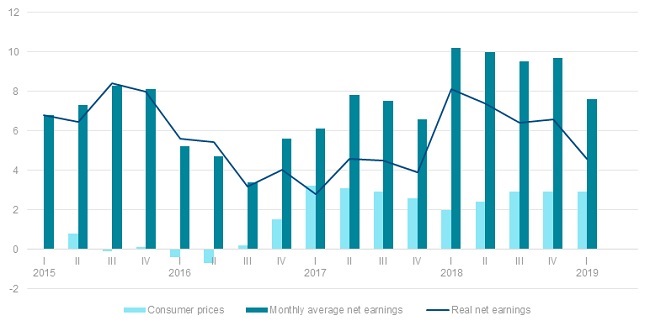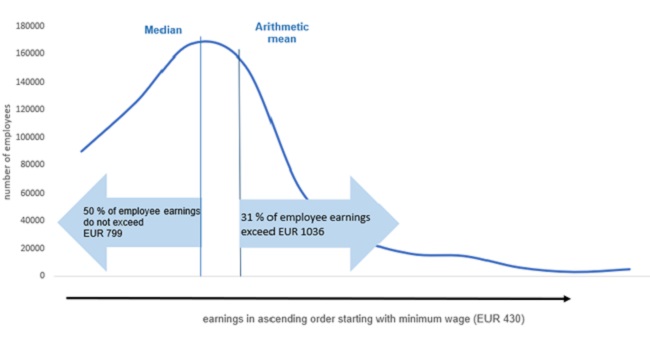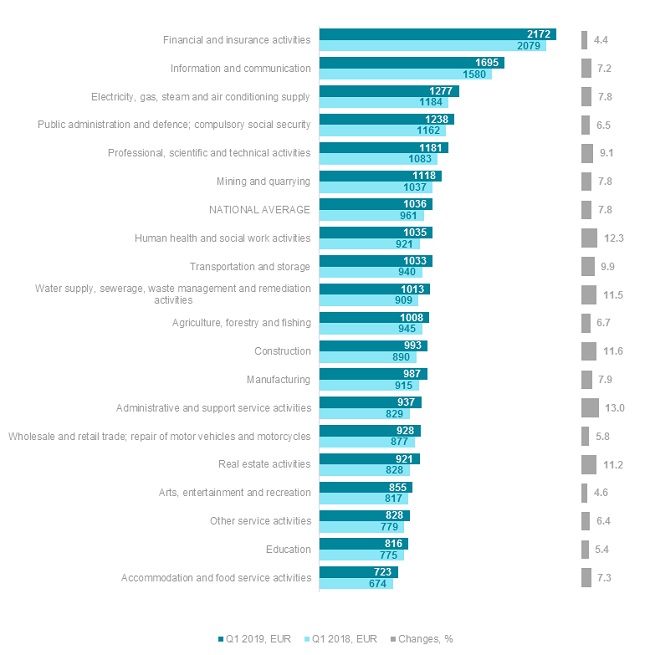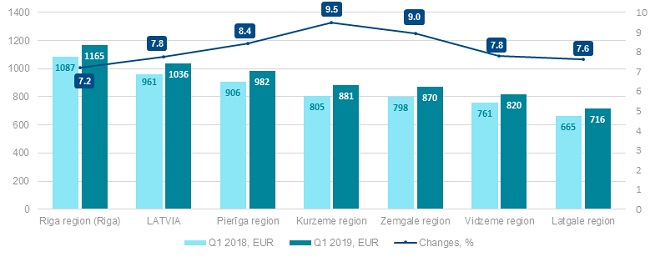Analytics, Good for Business, Latvia, Statistics, Wages
International Internet Magazine. Baltic States news & analytics
Friday, 26.04.2024, 16:34
Average gross salary in Latvia increased by 7.8% in Q1
 Print version
Print versionCompared to the 4th quarter of 2018, in the 1st quarter of 2019 gross wages and salaries dropped by 0.6%.
It should be noted that minimum wage did not change this year, and, compared to the neighbouring countries Lithuania and Estonia, Latvia had the lowest minimum wage – EUR 430. In 2019, minimum wage in Lithuania grew by EUR 155 or 38.8% (from EUR 400 to EUR 555), while in Estonia by EUR 40 or 8.0% (from EUR 500 to EUR 540).
Net wages and salaries constituted EUR 768
In the 1st quarter of 2019, the average net wages and salaries (calculated based on the labour taxes applicable at workplace) constituted EUR 768. Over the year, net earnings rose by 7.6%, while compared to the 4th quarter of 2018 they fell by 0.1%.
Considering annual consumer price growth of 2.9%, the real increase in net wages and salaries comprised 4.6%.
Changes in consumer prices and average wages and salaries
(as %, compared to the corresponding period of the previous year)

Median wages and salaries comprised EUR 799
In the 1st quarter of 2019, median gross wages and salaries amounted to EUR 799, and, compared to the 1st quarter of 2018 (when gross earnings constituted EUR 745), they grew slower than the mean arithmetic wages and salaries (rise of 7.2%). Net median wages (after taxes) constituted EUR 592 and rose by 7.1% over the year.
Median is calculated based on the information available in statistical surveys and administrative data of the State Revenue Service.
Median is an average indicator located in the middle of employee earnings sorted in an ascending or descending order. As median, compared to the mean arithmetic earnings, is not influenced by extremely high or low wages and salaries, it reflects typical earnings more precisely.

Sharper rise in earnings recorded in public sector
Over the year, wages and salaries in private sector grew faster than in public sector – by 8.4% and 6.8%, respectively. In the 1st quarter of 2019, monthly average gross earnings in private sector exceeded the indicator registered in public sector by EUR 3 (EUR 1 038 and EUR 1 035, respectively). Average wages and salaries in general government sector, which includes central and local government institutions, as well as enterprises controlled and financed by the central and local government, grew to EUR 985 or by 6.7%.
Changes
in average monthly wages and salaries by sector
(euros)
|
|
Q1 2018 |
Q4 2018 |
Q1 2019 |
Changes in Q1 2019, as % compared to |
|
|
Q1 2018 |
Q4 2018 |
||||
|
Total |
961 |
1042 |
1036 |
7.8 |
-0.6 |
|
private
sector |
958 |
1020 |
1038 |
8.4 |
1.8 |
|
public
sector |
969 |
1089 |
1035 |
6.8 |
-5.0 |
|
general
government sector |
923 |
1040 |
985 |
6.7 |
-5.3 |
Increase exceeding 10% registered in five economic activities
In the 1st quarter of 2019, the highest average wages and salaries for full-time work were registered in financial and insurance activities, information and communication, energy, public administration, professional, scientific and technical activities, as well as mining and quarrying. In other sectors, the average wages and salaries before taxes were below the national average.
The lowest wages and salaries, in turn, were observed in accommodation and food service activities, education, other service activities (that includes activities of public and other organisations, repair of computers and personal and household goods, washing and (dry-)cleaning, hairdressing and other beauty treatment, funeral and related activities), as well as arts, entertainment and recreation.
Highest earnings in financial and insurance activities and lowest in accommodation and food service activities
In the 1st quarter of 2019, the highest average wages and salaries for full-time work were registered in financial and insurance activities, information and communication, energy, public administration, professional, scientific and technical activities, as well as mining and quarrying. In other sectors, the average wages and salaries before taxes were below the national average.
The lowest wages and salaries, in turn, were observed in accommodation and food service activities, education, other service activities (that includes activities of public and other organisations, repair of computers and personal and household goods, washing and (dry-)cleaning, hairdressing and other beauty treatment, funeral and related activities), as well as arts, entertainment and recreation.
Average monthly gross wages and salaries in Q1 2018 and Q1 2019 and changes thereof

Lowest earnings still recorded in Latgale
Compared to the 1st quarter of 2018, in the 1st quarter of 2019 regional breakdown shows the sharpest rise in the average monthly gross wages and salaries in Kurzeme region (of 9.5%), followed by Zemgale (9.0%), and Pierīga (8.4%). The annual rise in Riga, having the highest wages and salaries (EUR 1 165), was the smallest – 7.2%. The lowest average gross wages and salaries for full-time work still were observed in Latgale region – EUR 716, constituting 69 % of the national average.









 «The Baltic Course» Is Sold and Stays in Business!
«The Baltic Course» Is Sold and Stays in Business!

